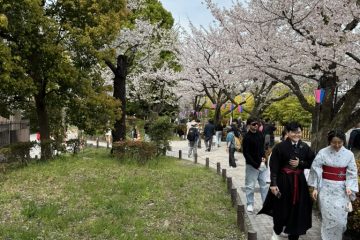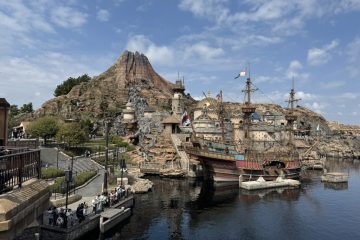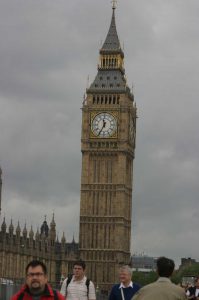 London, the food, the history, the legends and folk tales, the theater and … the traffic. We had gotten in the night before and returned the car without issue. Yes, traffic was bad, but we had our route well mapped out and short of an accident or road construction/detours, we had known where we were going. So, dropped the car off, a short taxi ride to the hotel and we slept through the night.
London, the food, the history, the legends and folk tales, the theater and … the traffic. We had gotten in the night before and returned the car without issue. Yes, traffic was bad, but we had our route well mapped out and short of an accident or road construction/detours, we had known where we were going. So, dropped the car off, a short taxi ride to the hotel and we slept through the night.
The next morning, we got up and went down for breakfast. Daryl had been complaining still about all the walking. He was sore and tired (and down several inches in his pants size). And while using a hiking stick/pole all around the smaller towns seemed okay, Daryl was a little apprehensive about using it in London. He told us that if we were going to walk about London, he would strike out on his own.
London
London is the capital and most populous city of England and the United Kingdom. Standing on the River Thames in the south east of the island of Great Britain.
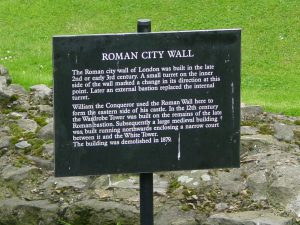
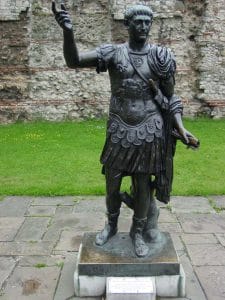 London has been a major settlement for two millennia. It was founded by the Romans, who named it Londinium. London’s ancient core, the City of London, largely retains its 1.12-square-mile (2.9 km2) medieval boundaries.
London has been a major settlement for two millennia. It was founded by the Romans, who named it Londinium. London’s ancient core, the City of London, largely retains its 1.12-square-mile (2.9 km2) medieval boundaries.
Since at least the 19th century, “London” has also referred to the metropolis around this core, historically split between Middlesex, Essex, Surrey, Kent and Hertfordshire, which today largely makes up Greater London, a region governed by the Mayor of London and the London Assembly.
We convinced him that we were going to be doing some walking, but less. Since the public transportation was good, we would be taking the underground and tube and busses. He decided to stick with us. After all, he wanted to see London Tower, Big Ben and London bridge too.
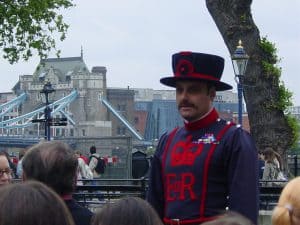 We took the tubes over to the Tower of London. Just outside the station, we saw the remnants of a Roman wall, reminding us of the long history London has had. Once inside, we joined a group being lead by a “beef-eater”.
We took the tubes over to the Tower of London. Just outside the station, we saw the remnants of a Roman wall, reminding us of the long history London has had. Once inside, we joined a group being lead by a “beef-eater”.
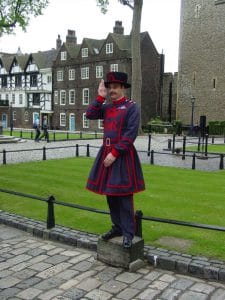 The Beefeaters are often confused with ‘Yeomen of the Guard’, a distinctly different corps of Royal Bodyguards. Beefeaters at the Tower of London are the ceremonial guardians, and historically, they would have been responsible for the safeguarding of the Crown Jewels, and looking after prisoners kept at the Tower.
The Beefeaters are often confused with ‘Yeomen of the Guard’, a distinctly different corps of Royal Bodyguards. Beefeaters at the Tower of London are the ceremonial guardians, and historically, they would have been responsible for the safeguarding of the Crown Jewels, and looking after prisoners kept at the Tower.
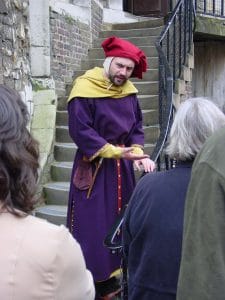 We saw several ravens in the courtyard and learned the legend, that as long as there are ravens in the tower, London shall never fall. We also got to see the crown jewels, and the torture chambers and prisoner cells.
We saw several ravens in the courtyard and learned the legend, that as long as there are ravens in the tower, London shall never fall. We also got to see the crown jewels, and the torture chambers and prisoner cells.
London Tower is a must see site of London.
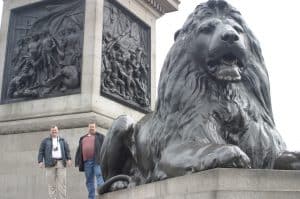 Next, we went to Trafalgar Square. We had seen the Lion statues and Daryl wanted to get up close. He had a fascination with the lions.
Next, we went to Trafalgar Square. We had seen the Lion statues and Daryl wanted to get up close. He had a fascination with the lions.
Trafalgar Square is a public square in the City of Westminster, Central London, built around the area formerly known as Charing Cross. Its name commemorates the Battle of Trafalgar, a British naval victory in the Napoleonic Wars with France and Spain that took place on 21 October 1805 off the coast of Cape Trafalgar, Spain.
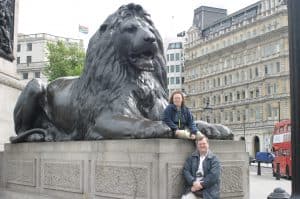 The site of Trafalgar Square had been a significant landmark since the 13th century and originally contained the King’s Mews. After George IV moved the mews to Buckingham Palace, the area was redeveloped by John Nash, but progress was slow after his death, and the square did not open until 1844. The 169-foot (52 m) Nelson’s Column at its centre is guarded by four lion statues. A number of commemorative statues and sculptures occupy the square, but the Fourth Plinth, left empty since 1840, has been host to contemporary art since 1999.
The site of Trafalgar Square had been a significant landmark since the 13th century and originally contained the King’s Mews. After George IV moved the mews to Buckingham Palace, the area was redeveloped by John Nash, but progress was slow after his death, and the square did not open until 1844. The 169-foot (52 m) Nelson’s Column at its centre is guarded by four lion statues. A number of commemorative statues and sculptures occupy the square, but the Fourth Plinth, left empty since 1840, has been host to contemporary art since 1999.
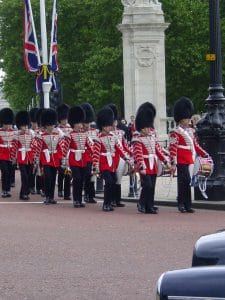 From there, we went to Buckingham Palace. We go there in time to see the changing of the guards. We were able to get a decent spot, but as the band was heading out, I decided I needed a better vantage point. I told Teresa to stay put and I took off running, crossing a street and trying to get a better angle. I stopped near a corner and as I was backing up, I bumped a horse with a mounted police officer. I turned and apologized. She informed me that I was lucky. Puzzled, I asked why? She pointed to a building top and another officer not too far away. On top of the building was a rifleman and the other officer had his hand on his weapon. Apparently, a big guy with a back pack “charging” around the palace is frowned upon. She told me that if she had not seen me trying to use me camera…. well… I apologized and promised to be more careful.
From there, we went to Buckingham Palace. We go there in time to see the changing of the guards. We were able to get a decent spot, but as the band was heading out, I decided I needed a better vantage point. I told Teresa to stay put and I took off running, crossing a street and trying to get a better angle. I stopped near a corner and as I was backing up, I bumped a horse with a mounted police officer. I turned and apologized. She informed me that I was lucky. Puzzled, I asked why? She pointed to a building top and another officer not too far away. On top of the building was a rifleman and the other officer had his hand on his weapon. Apparently, a big guy with a back pack “charging” around the palace is frowned upon. She told me that if she had not seen me trying to use me camera…. well… I apologized and promised to be more careful.
I went back to Teresa and told her what happened. We decided to play it a little more low key.
Next, we decided to hit up the Royal Albert Hall. We were not sure if there were tours inside, but the outside would be okay. Kensington Gardens which are just north are spectacular. They almost rival the gardens in Versailles.
Royal Albert Hall
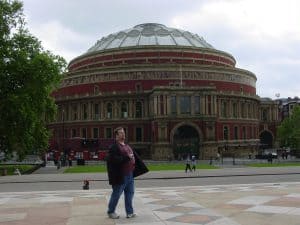 The Royal Albert Hall is a concert hall on the northern edge of South Kensington, London, which has held the Proms concerts annually each summer since 1941. It has a capacity of up to 5,272 seats. The Hall is a registered charity held in trust for the nation and receives no public or government funding.
The Royal Albert Hall is a concert hall on the northern edge of South Kensington, London, which has held the Proms concerts annually each summer since 1941. It has a capacity of up to 5,272 seats. The Hall is a registered charity held in trust for the nation and receives no public or government funding.
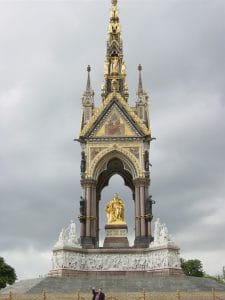
Since its opening by Queen Victoria in 1871, the world’s leading artists from many performance genres have appeared on its stage and it has become one of the UK’s most treasured and distinctive buildings. The location of some of the most notable events in British culture, each year it hosts more than 390 shows in the main auditorium, including classical, rock and pop concerts, ballet, opera, film screenings with live orchestra, sports, award ceremonies, school and community events, charity performances and banquets. A further 400 events are held each year in the non-auditorium spaces.
The Hall was originally supposed to have been called the Central Hall of Arts and Sciences, but the name was changed to the Royal Albert Hall of Arts and Sciences by Queen Victoria upon laying the Hall’s foundation stone in 1867, in memory of her husband, Prince Albert, who had died six years earlier. It forms the practical part of a memorial to the Prince Consort – the decorative part is the Albert Memorial directly to the north in Kensington Gardens, now separated from the Hall by Kensington Gore.
At this point, Daryl had had enough and wanted to strike out on his own. We agreed that since this was London, we would find and meet up at the original Hard Rock for dinner that night.
Teresa wanted to see “The Globe theater” and we took off in that direction.
 The Globe Theatre was a theatre in London associated with William Shakespeare. It was built in 1599 by Shakespeare’s playing company, the Lord Chamberlain’s Men, on land owned by Thomas Brend and inherited by his son, Nicholas Brend and grandson Sir Matthew Brend, and was destroyed by fire on 29 June 1613. A second Globe Theatre was built on the same site by June 1614 and closed by an Ordinance issued on 6 September 1642.
The Globe Theatre was a theatre in London associated with William Shakespeare. It was built in 1599 by Shakespeare’s playing company, the Lord Chamberlain’s Men, on land owned by Thomas Brend and inherited by his son, Nicholas Brend and grandson Sir Matthew Brend, and was destroyed by fire on 29 June 1613. A second Globe Theatre was built on the same site by June 1614 and closed by an Ordinance issued on 6 September 1642.
A modern reconstruction of the Globe, named “Shakespeare’s Globe”, opened in 1997 approximately 750 feet (230 m) from the site of the original theatre. From 1909, the current Gielgud Theatre was called “Globe Theatre”, until it was renamed (in honour of John Gielgud) in 1994.
We got there in time to see a dress rehearsal for an up coming play. We were asked to not take pictures of the performers and once the practice wrapped, we would have photo opportunites.
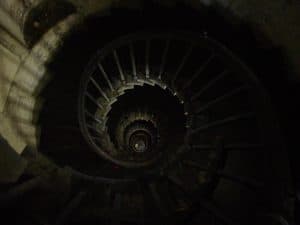 Walking to the tube, Teresa and I found a column/tower in the middle of a street. It was a monument and was open to the public. For a pittance, one could walk the spiral stair case up. Of course, what goes up must also come down and once down, you were given a “I completed” certificate.
Walking to the tube, Teresa and I found a column/tower in the middle of a street. It was a monument and was open to the public. For a pittance, one could walk the spiral stair case up. Of course, what goes up must also come down and once down, you were given a “I completed” certificate. 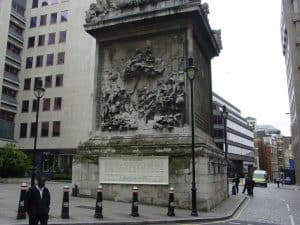
We got to the station and took it and a bus to get to the Hard Rock. Daryl was just getting off a double-decker as we arrived. We had a good dinner and several drinks, celebrating a good trip and good friendship. We toasted to friends who missed out (“To their loss!”) and eventually went back to the hotel.
Until next time….

